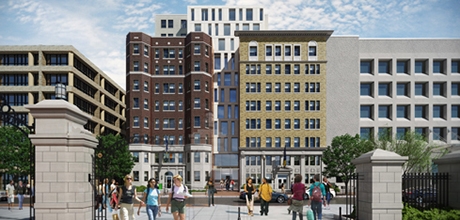At a May 20 D.C. Zoning Commission hearing for the George Washington University’s proposed new residence hall, GW students and administrators stressed the benefits of the new building. In addition to providing nearly 900 on-campus housing spots, the project will add student meeting space in the core of the Foggy Bottom Campus, while creating additional neighborhood retail and promoting the university’s sustainability and historic preservation goals.
The new residence hall will be created by retaining the existing facades and historically significant front portions of the eight-story Crawford, Schenley and West End residence halls and constructing a new 12-story building between the existing halls on what is currently an open-air alley and parking area. The project will allow for approximately 898 beds, as well as first-floor and lower-level food and retail venues and student programming space. The planned 898 beds represent an increase of 332 spots over the current capacity of the three residence hall buildings.
The increase in beds at this site will offset the planned discontinuation of undergraduate housing at City Hall, an off-campus property, as required by the 2007 Foggy Bottom Campus Plan.
“This project contributes so much to the student experience on campus and also brings to life so many of the goals and benefits of the ‘grow up, not out’ philosophy of the 2007 Foggy Bottom Campus Plan,” said Alicia Knight, senior associate vice president for operations. “The new residence hall will bring off-campus student beds into the core of our campus and create new campus and community-serving retail space. This will further enhance the Eye Street retail corridor, while preserving the existing historic structures.”
In keeping with the university’s recent developments, this project will target a minimum of Silver certification under the Leadership in Energy and Environmental Design (LEED) Green Building Rating System. The new building will incorporate features such as an extensive green roof area, cisterns to capture rainfall and other features to achieve water reductions and energy savings.
Pending approval by the D.C. Zoning Commission, the anticipated timeline would include demolition beginning this summer of the existing residence halls, followed by excavation in early 2014 and construction in late 2014. A completion date of summer 2016 is planned, with occupancy in the fall 2016 semester.
Madeleine Louden, a rising junior and one of several GW students who testified in support of the project, said she was enthusiastic about the changes the project would bring.
“It will place students in the heart of campus, nearer to both academic and student life hubs, and provide much-needed student space,” she said.
Ms. Knight said the project’s ground-floor retail establishments will extend the existing Eye Street retail corridor between The Avenue (2200 Pennsylvania Avenue) and the Shops at 2000 Penn. The new building will also include lower-level retail options, accessible from both H and Eye streets, and will also provide flexible student space for new student living and learning areas.
The new hall will contain faculty‐in‐residence apartments as well as three styles of housing: efficiency doubles with kitchens, quads similar to those in Ivory Tower residence hall, and new affinity-housing units that will accommodate 16 to 20 students affiliated with a particular organization. These units will include multiple bedrooms and a large communal kitchen and common area.
At the hearing, rising senior Miles Milliken, a two-year affinity housing resident, praised the inclusion of more affinity housing opportunities.
"Affinity housing greatly enhanced my time at GW,” he said. “Living with peers in my major not only strengthened my GPA, but my friendships as well. This project is not just designed to be another residence hall, but to help students build unique, rich experiences at GW.”
There are an additional five Campus Plan projects now underway on the Foggy Bottom campus. The university’s Site 75A project—the redevelopment of townhouses in the 2100 block of Pennsylvania Ave. and an existing unoccupied investment property at 2100 West Pennsylvania Ave. to create a new commercial building—recently received approval from the D.C. Zoning Commission. There are three sites currently under construction: the School of Public Health and Health Services building, the Science and Engineering Hall, and the new museum building.
GW completed its first Campus Plan project earlier this year: the G Street Garage (2028 G Street) includes four levels of underground parking and one level of below-ground program space for the Law School. This project’s parking replaces some of the parking spaces lost in demolition of the University Parking Garage (for construction of the Science and Engineering Hall) and related decentralization of parking—both of which are important components of the Campus Plan.


